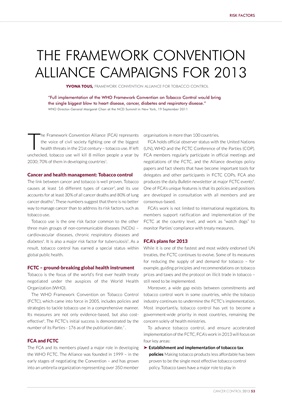
RISK FACTORS
THE FRAMEWORK CONVENTION
ALLIANCE CAMPAIGNS FOR 2013
YVONA TOUS, FRAMEWORK CONVENTION ALLIANCE FOR TOBACCO CONTROL
“Full implementation of the WHO Framework Convention on Tobacco Control would bring
the single biggest blow to heart disease, cancer, diabetes and respiratory disease.”
WHO Director-General Margaret Chan at the NCD Summit in New York, 19 September 2011
T
he Framework Convention Alliance (FCA) represents organisations in more than 100 countries.
the voice of civil society fighting one of the biggest FCA holds official observer status with the United Nations
health threats in the 21st century – tobacco use. If left (UN), WHO and the FCTC Conference of the Parties (COP).
unchecked, tobacco use will kill 8 million people a year by FCA members regularly participate in official meetings and
1
2030; 70% of them in developing countries . negotiations of the FCTC, and the Alliance develops policy
papers and fact sheets that have become important tools for
Cancer and health management: Tobacco control delegates and other participants in FCTC COPs. FCA also
The link between cancer and tobacco is well proven. Tobacco produces the daily Bulletin newsletter at major FCTC events8.
causes at least 16 different types of cancer2, and its use One of FCA’s unique features is that its policies and positions
accounts for at least 30% of all cancer deaths and 80% of lung are developed in consultation with all members and are
3
cancer deaths . These numbers suggest that there is no better consensus-based.
way to manage cancer than to address its risk factors, such as FCA’s work is not limited to international negotiations. Its
tobacco use. members support ratification and implementation of the
Tobacco use is the one risk factor common to the other FCTC at the country level, and work as “watch dogs” to
three main groups of non-communicable diseases (NCDs) – monitor Parties’ compliance with treaty measures.
cardiovascular diseases, chronic respiratory diseases and
diabetes4. It is also a major risk factor for tuberculosis5. As a FCA’s plans for 2013
result, tobacco control has earned a special status within While it is one of the fastest and most widely endorsed UN
global public health. treaties, the FCTC continues to evolve. Some of its measures
for reducing the supply of and demand for tobacco – for
FCTC – ground-breaking global health instrument example, guiding principles and recommendations on tobacco
Tobacco is the focus of the world’s first ever health treaty prices and taxes and the protocol on illicit trade in tobacco –
negotiated under the auspices of the World Health still need to be implemented.
Organization (WHO). Moreover, a wide gap exists between commitments and
The WHO Framework Convention on Tobacco Control tobacco control work in some countries, while the tobacco
(FCTC), which came into force in 2005, includes policies and industry continues to undermine the FCTC’s implementation.
strategies to tackle tobacco use in a comprehensive manner. Most importantly, tobacco control has yet to become a
Its measures are not only evidence-based, but also cost- government-wide priority in most countries, remaining the
6
effective . The FCTC’s initial success is demonstrated by the concern solely of health ministries.
number of its Parties - 176 as of the publication date.7 . To advance tobacco control, and ensure accelerated
implementation of the FCTC, FCA’s work in 2013 will focus on
FCA and FCTC four key areas:
The FCA and its members played a major role in developing ‰ Establishment and implementation of tobacco tax
the WHO FCTC. The Alliance was founded in 1999 – in the policies Making tobacco products less affordable has been
early stages of negotiating the Convention – and has grown proven to be the single most effective tobacco control
into an umbrella organization representing over 350 member policy. Tobacco taxes have a major role to play in
CANCER CONTROL 2013 53